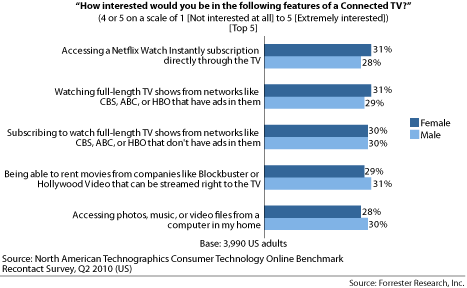The Data Digest: Interest In Connected TVs
The concept of traditional TV watching needs to be redefined. The TV has evolved from a passive device with a single content source to a simple, large-display screen on which numerous activities come together. In the past, consumers had a TV device (typically the set-top box), a movie device (typically the DVD player), and possibly a gaming device connected to the TV. But now, the game console streams movies, the set-top box records TV, and the PC does everything. The next step is connected TVs — HDTVs that incorporate a direct connection to the Internet, whether wired or wireless.
Connected TVs are a big deal to manufacturers, but Forrester Technographics® data found that consumers are struggling to understand the benefits. One of the challenges that manufacturers of these TVs face is that when viewers are in "TV mode," they seem unable to imagine doing anything with these TVs other than watching more TV. When questioned, people appear to want one thing: more video. The top responses focus on getting access to well-known sources of TV shows and movies like Netflix, Blockbuster, or regular broadcast and cable networks, both for men and women.

Despite this lack of consumer interest, Forrester predicts that connected TVs will reach one-third of homes by 2015. Why are we so bullish on the future penetration of these devices? It's simple: TV makers and retailers are pushing these TVs into consumer homes. This may result in 43.2 million US homes having a connected TV by the end of 2015, but the level to which they'll actually be used depends on the features and capabilities that manufacturers offer.